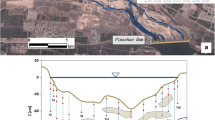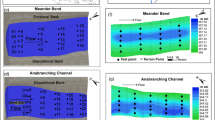Abstract
Estimation of the leakage rate from riverbeds is an important task to quantify the interaction between surface and ground waters and to perform effective management of water resources, especially under arid climate conditions, where leakage from riverbeds helps to preserve the existence of riparian ecosystems. One of the methods for estimating the leakage rate from a riverbed is the use of diurnal temperature oscillations in riverbed sediments. The data from monitoring the temperature of the sediments in the lower reaches of the Heihe riverbed (northwestern China) are used to calculate the leakage rate from the riverbed. The results of the leakage rate calculations are compared to the data obtained by solving an inverse problem using the one-dimensional model of heat and moisture transfer in the riverbed sediments according to the data of the annual observation cycle. Good agreement of the calculated and model leakage rates is observed when the temperature sensors, whose data are used for the calculation of the leakage rates, are spaced at a significant distance (≥0.3 m) and at a depth greater than 0.3 m.



Similar content being viewed by others
REFERENCES
Gordon, R.P., Lautz, L.K., Briggs, M.A., and McKenzie, J.M., Automated calculation of vertical pore-water flux from field temperature time series using the VFLUX method and computer program, Hydrology J., 2012, vol. 420, pp. 142–158.
Hatch, C.E., Fisher, A.T., Revenaugh, J.S., et al., Quantifying surface water-groundwater interactions using time series analysis of streambed thermal records: Method development, Water Resour. Res., 2006, vol. 42, no. 10, pp. 1–14.
Irvine, D.J., Briggs, M.A., Lautz, L.K., et al., Using diurnal temperature signals to infer vertical groundwater-surface water exchange, Groundwater J., 2017, vol. 55, no. 1, pp. 10–26.
Stallman, R.W., Steady one-dimensional fluid flow in a semi-infinite porous medium with sinusoidal surface temperature, Geophys. Res. J., 1965, no. 12, pp. 2821–2827.
Vasilevskiy, P.Yu., Wang, Ping., Pozdniakov, S.P., and Davis, P., Revisiting the modified Hvorslev formula to account for the dynamic process of streambed clogging: Field validation, Hydrology J., 2019, vol. 568, pp. 862–866.
Wang Ping, Pozdniakov, S.P., and Vasilevskiy, P.Yu., Estimating groundwater-ephemeral stream exchange in hyper-arid environments: Field experiments and numerical simulations, Hydrology J., 2017, vol. 555, pp. 68–79.
Funding
This work was supported by the grant for the joint competition in the Russian Foundation for Basic Research – National Natural Science Foundation of China projects (project no. 18-55-53025 GFEN_a, 41811530084).
Author information
Authors and Affiliations
Corresponding authors
Additional information
Translated by L. Mukhortova
About this article
Cite this article
Vasilevskii, P.Y., Ping Wang Estimation of the Leakage Rate from a Riverbed According to the Data of Diurnal Temperature Oscillations in Riverbed Sediments (based on the Example of the Heihe River, Inner Mongolia, China). Moscow Univ. Geol. Bull. 75, 80–85 (2020). https://doi.org/10.3103/S0145875220010159
Received:
Revised:
Accepted:
Published:
Issue Date:
DOI: https://doi.org/10.3103/S0145875220010159




